Paper maker
In the pandemic Rike Lenzing started turning paper into pieces of jewellery from her home in Cork city. Next month her paper creations will be on show across Cork for Craft Month.
In her long career as an artist Rike Lenzing has worked with glass, tiles, stone, paints, metals and much else. But when the pandemic hit and she realised that it wasn’t going to blow over quickly she decided she was going to return to a material that she has used and loved since her childhood: paper.
When you think about it paper is the first material that we (still) encounter as children. Our first artistic endeavours are usually done on a scrap of paper with some crayons (until we graduate to a scissors), and even if you don’t have a crayon or pencil to hand, paper, just by itself offers limitless opportunities to create. Hello, origami. In fact, paper is the original blank canvas.
Despite the digitisation of everything, paper (still) has sway. You’ll find stacks, sheets and bundles of it in homes, classrooms and offices. And it was to a pile of such paper, in the form of old calendars, that Rike turned to when she decided she was going to reacquaint herself with the thousands-year-old material and get creative.
I first came across images of Rike’s handmade paper jewellery online, but standing in her studio holding one of the intricate and expertly folded paper necklaces, there’s a certain disconnect, which goes something like this: how did she transform a calendar into a sculpted piece of beauty?
The answers lie in the neat and tidy little studio space that Rike has tucked up against a wall midway between her kitchen and living room in a house that is filled with paintings and mosaics. An old wooden easel which has been refashioned into a paper holder leans against the side of her work station: thousands of hand cut strips of paper, all the colours of the rainbow, are fastened by hooks to the easel. Bit by bit in a repetitive and laborious process, Rike takes from the stockpile, and in a creative process that unfolds over hours and days those strips of paper are added to each other until a piece of paper jewellery is created.
(It sounds simple. But so too does oirgami, climbing a mountain, or skiing. But there’s a craft and a skill to each endeavour.)
Together with scores of other crafters and makers, Rike’s paper jewellery will be on display around the city and county as part of Cork Craft Month which is run by Cork Craft and Design.
This week when I called by her home, Rike was busy deciding which pieces will go where: her necklaces, earrings and bracelets have been in the museum shop at The Glucksman for more than a year, and she’ll also be showing and selling them at The Old Mill in Castletownroche, as well as at Cork Craft and Design’s shop in Douglas Woollen Mills.
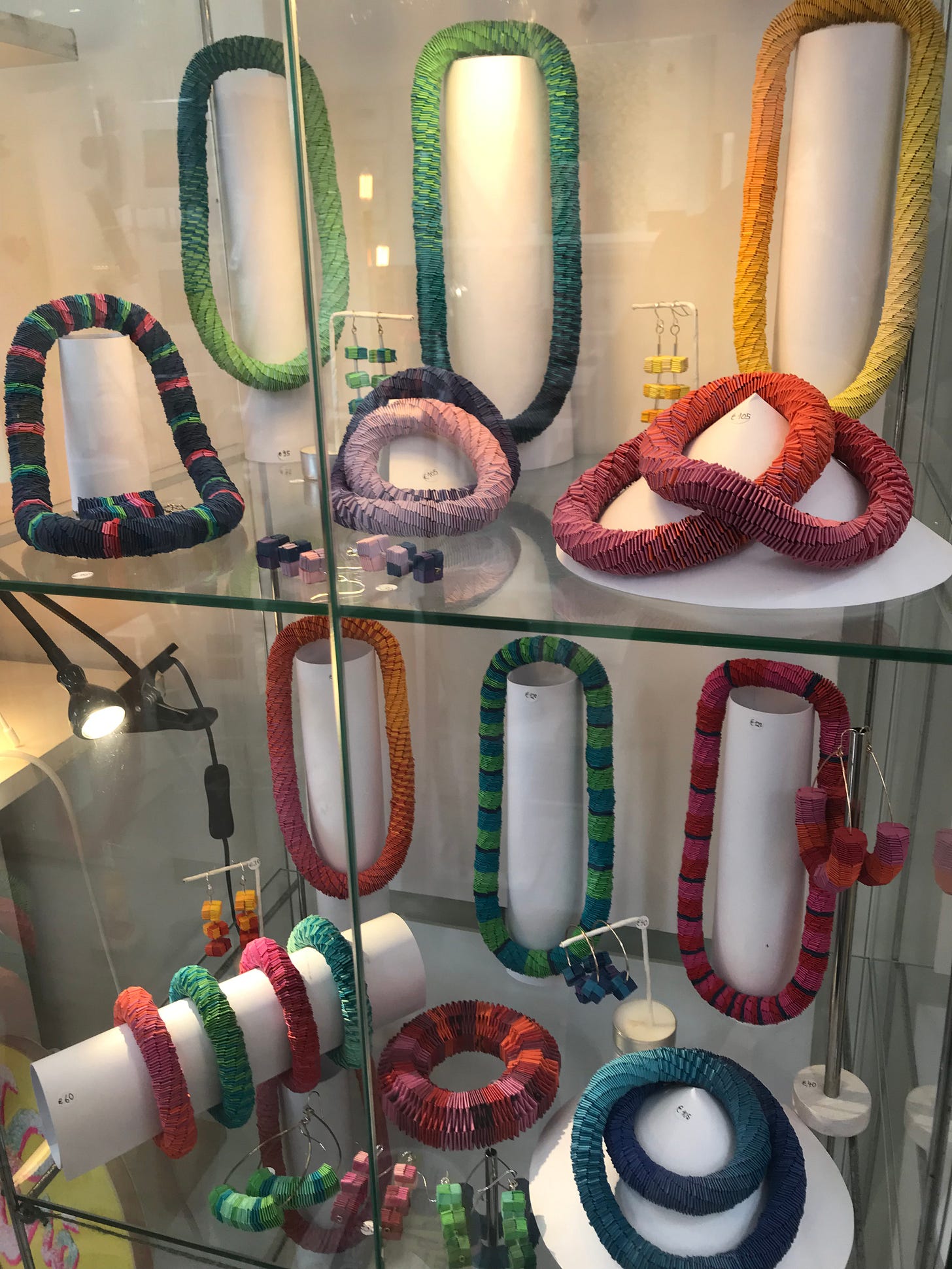
Returning to the fold
A few things consolidated in Rike’s mind during the start of the pandemic. As she told me, she didn’t want to get back into the “rat race of the art world”, especially as she loves her home life, and she had been thinking about creating with paper for some time, but she also wanted to work with what’s close to hand - hence the calendars.
“I just like making things, and this appealed to me,” she says.
“I mean women have always worked from home with crocheting or lace making and all that and so I said, ‘sure that’s no different, that’s the same type of thing, just in the 21st Century’”.
So I use paper, but recycled paper and then I also use fresh sheets.”
Rike has also looked at plastic, specifically reusing plastic bottles and plastic bags, and she’s still experimenting in that area and will likely incorporate plastic in her jewellery line-up at some stage.
But, as she said, paper has long been a part of her artistic life; it’s familiar territory for her and one that she loves and appreciates.
“I started as a printmaker and in book publishing in Germany and I just love stationary shops as well.”
Rike, like many, many others could happily spend hours in a stationery shop perusing reams of papers and sizing up the cutting tools and punchers and stamps.
She first landed in Dingle more than 40 years ago, where she guided holidaymakers around on ponies and horses. Growing up in Germany, she knew she wanted to live in an area of natural wilderness and beauty, and it was this aspect which first attracted her to Ireland. After Dingle, she made the move to Cork where she completed a degree in fine arts at the Crawford.
Most of all what Rike liked about a return to working with paper was that it was limiting, but also centred on a concept that forms the basis of the way we will have to live to survive and keep the planet alive; sustainability, or working within our limits, with the resources we have and trying to limit waste.
As Rike said, “I decided I was going to start with whatever I have here around me which was the basic materials and I said I would keep it simple and I will work with those restrictions”.
She told herself “not to escape”, and to keep going until she had created something.
Over time, and trial and error and a lot of YouTube videos her craft began to take shape and the hours of folding paid off.
There’s probably a few assumptions that many people have about jewellery made from paper, or indeed anything made from paper, and they run from the practical to the absurd.
For example, what if you tear it? It is, after all, made from paper. That’s unlikely though. There’s a dexterity to Rike’s jewellery that you only appreciate once it’s actually in your hand. Also, for her pieces she generally foregoes using metal clasps, instead she uses strong, sturdy fishing gut-like wire called monofilament which runs inside the paper-made pieces, allowing you to stretch the necklace over your head. The end result is that although it’s paper-made, there’s a surprising robustness to it.
Secondly, what if you went out in the rain, what would happen to your paper necklace? You probably wouldn’t wear one of Rike’s pieces out in a typhoon, but then again, you probably wouldn’t go out in a typhoon, so as with all things in life, let common sense prevail.
“I have a lot of trust in paper,” Rike said. “But, I wouldn’t leave out in the rain,” she adds pragmatically.
“Paper is part of us”
During the process of making a necklace Rike will spend hours thinking about colour and form. Her sketchbooks and notebooks are filled with colour wheels and little strips of paper she labels with letters in order to help her with colour gradation as she folds her creation into completion.
Sometimes she will also switch in different folding techniques which will lead to different transitions and give the overall piece a different look and feel.
The natural world and colour have always been an inspiration for Rike, but she’s also guided by what she calls “clear architectural and contemporary lines.”
Likewise, she’s also guided by her own tastes in jewellery (and her daughter will also give her opinion too when asked).
“When I go out I like to put jewellery on, but I don’t just put jewellery on,” Rike said.
“It really matters to me if I wear a black dress because it needs just one thing to make this black dress shine. So I need something clean and jewellery speaks for itself then, or it’s the focus point,” she said.
Over the first year of the pandemic, Rike perfected her folding techniques and from there she just kept at it. And that’s the thing with making things from paper, you excel through repetition, from the countless hours or folding and folding and refolding.
By coincidence, when the pandemic broke, I was living in Japan with my family and we had planned to move back to Ireland, but, the lockdowns pushed everything back. At the time I read a story in the New York Times from a journalist aquantaince I know who took up origami so she could practice making a paper crane with her daughter. There’s a tradition in Japan of making a thousand paper cranes called senbazuru, which are subsequently given to someone who is ill to help them recover quickly.
And so I thought I’d take up making a paper crane ever day early on in the pandemic, with my son as my guide.
I lasted three days, which says more about me than anything else. As Rike says, so much of origami and paper folding is building up muscle memory and discipline too, but the pay off is immense. The end results of origami, and indeed paper jewellery creations, are limitless and beautiful. While I was in her house, Rike demonstrated a folding technique which all looked very simple and yet after a few seconds left me entirely confused.

Rike said it took her a year to convince herself she could do it and she wasn’t a “one-hit wonder”.
So in 2021, she set out to find somewhere that might stock her paper jewellery and through a series of conversations and connections she was steered to the museum shop in The Glucksman, which is also in her neighbhourhood.
The Glucksman gave an emphatic “yes”, but Rike needed to get marketing and promotional materials ready, which can be time consuming and difficult for a lot of people working in the creative industries.
Rike’s formed a lot of connections through Pinterest and Instagram, but the digital platforms are new landscapes for her, and there’s quite a significant amount of learning required when it comes to setting up marketplaces on those platforms.
Even when it comes to how Rike presents her jewellery, she takes a very simple and sustainable approach. Her necklaces hang around blouses cut from sheets of A4 paper; or they sit atop a cone made from paper.
There’s a lot that Rike wants to accomplish. She wants to enrol in night classes to learn more about iron and metal work; she wants to think more about how she could fold plastic into her work and she wants to get her jewellery into more shops and boutiques and do more to promote her work online.
But she also wants to work within certain confines. She’s modest by nature, and she’s grateful for her home and family life in Cork and that for a few hours every day she gets to settle down in her studio space on the banks of the Lee and take a few sheets of paper and transform them into creations that don’t cost the world.
Paper has staying power Rike says, pointing out that books have been with us for hundred of years.
“And paper can be so playful,” she adds. “All you need really is a scissors, glue and paper.”
“Paper is part of us.”
You can see more of Rike’s work over at her Instagram account where she can also be contacted about comissions.
Cork Craft Month runs from August 1-31 in locations across the city and county. To find out more about the crafters and where you can see their work as well as workshops, exhibitions and talks visit the Cork Craft Month program of events here.




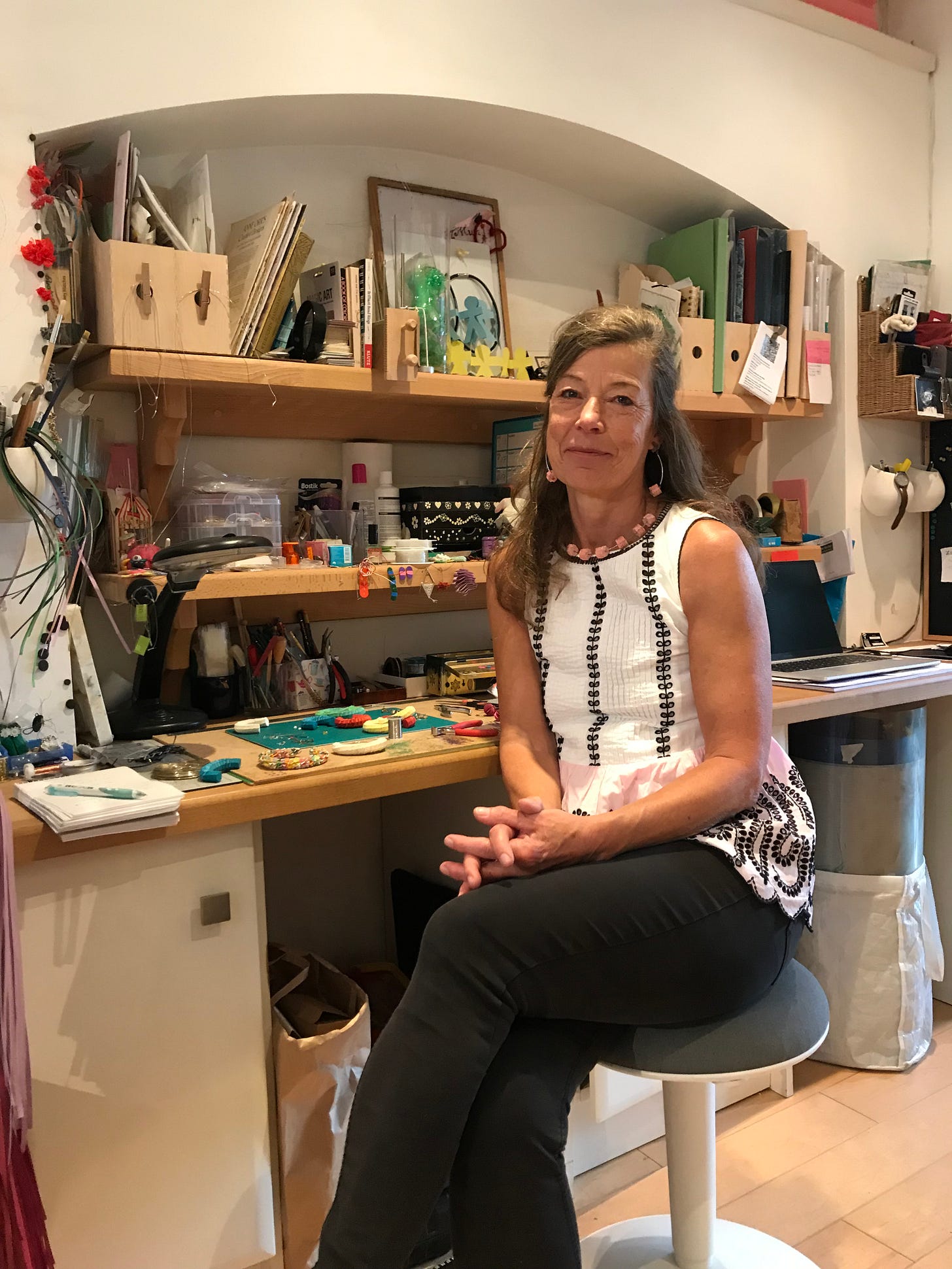
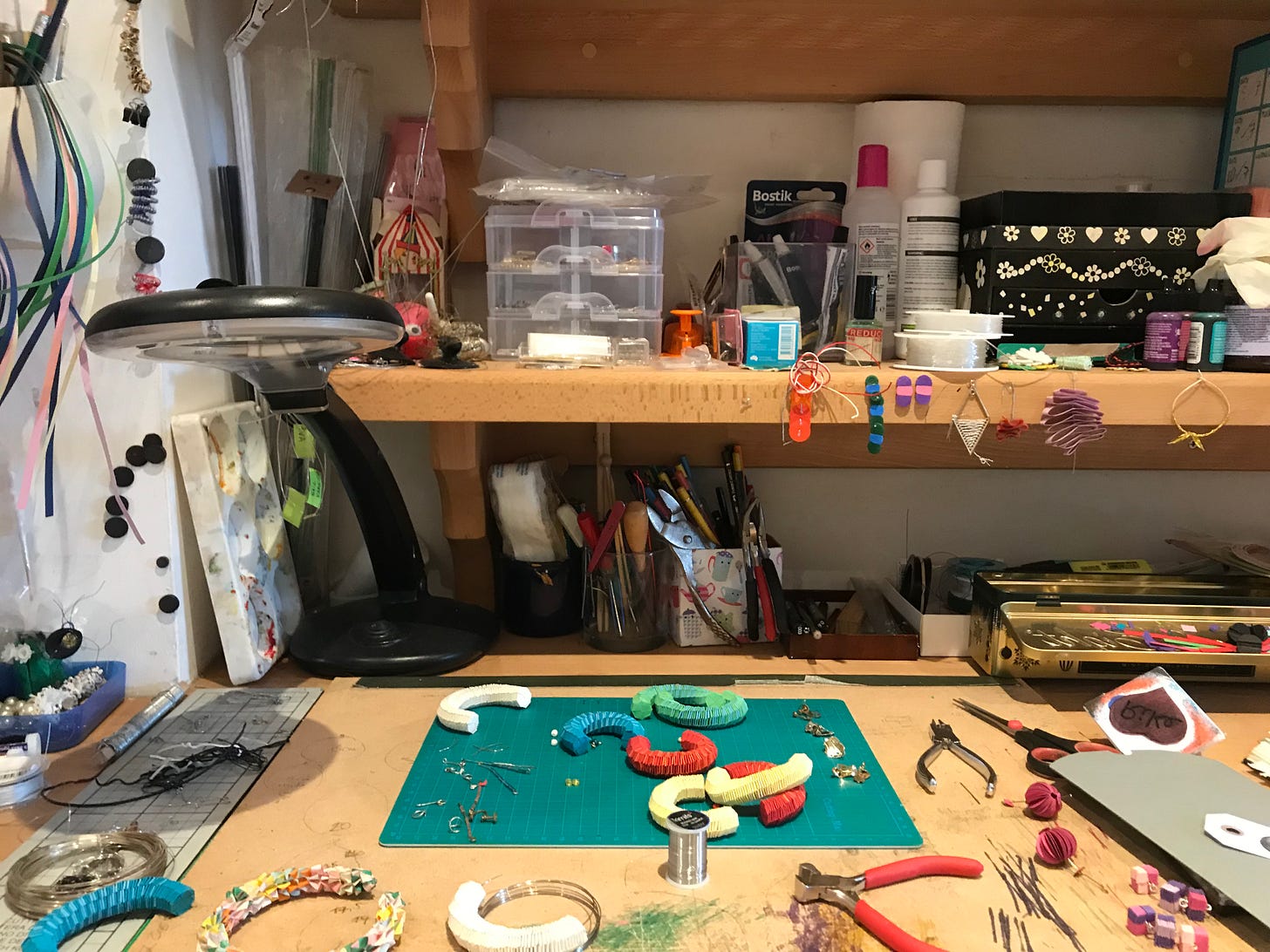
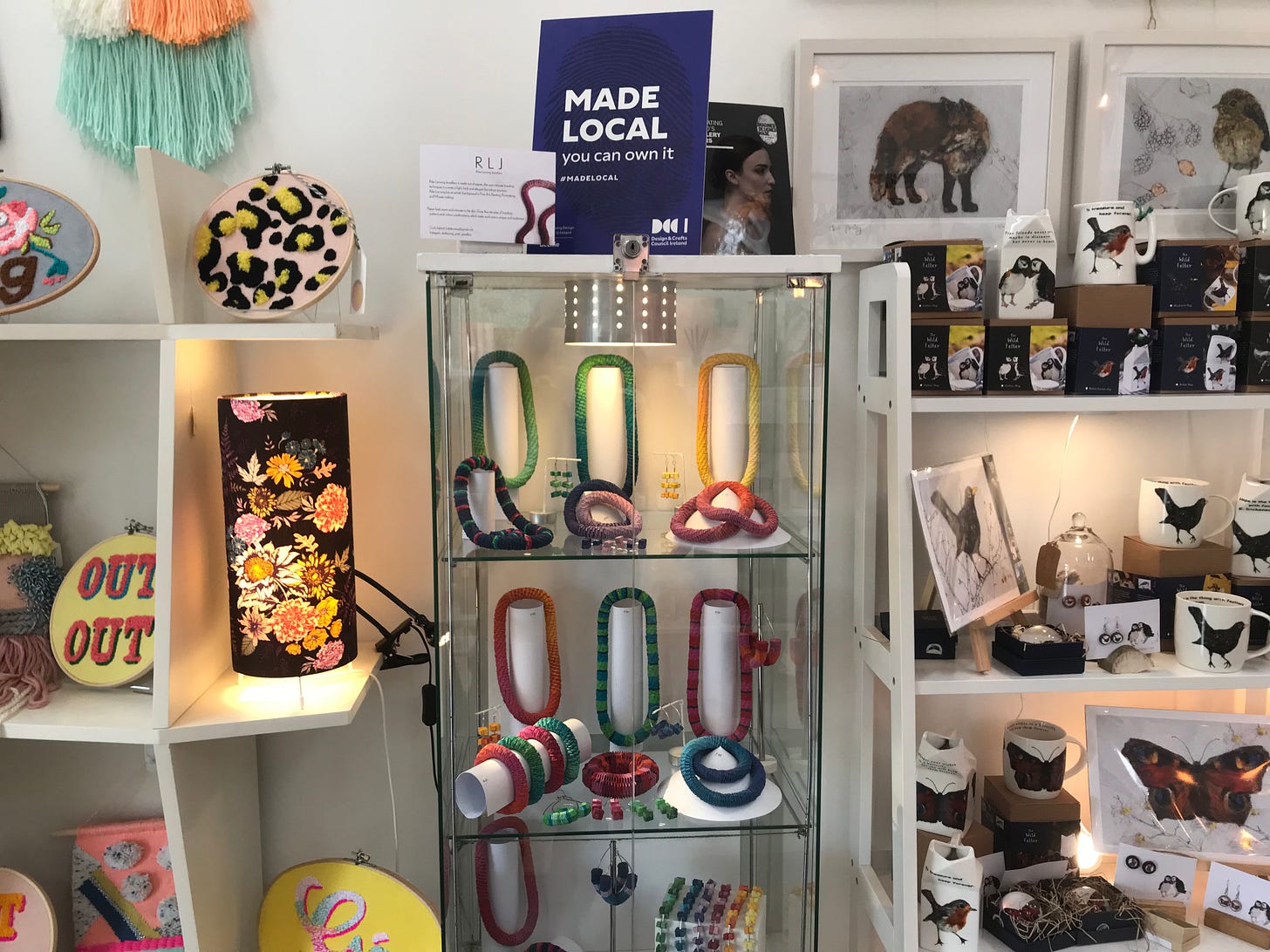
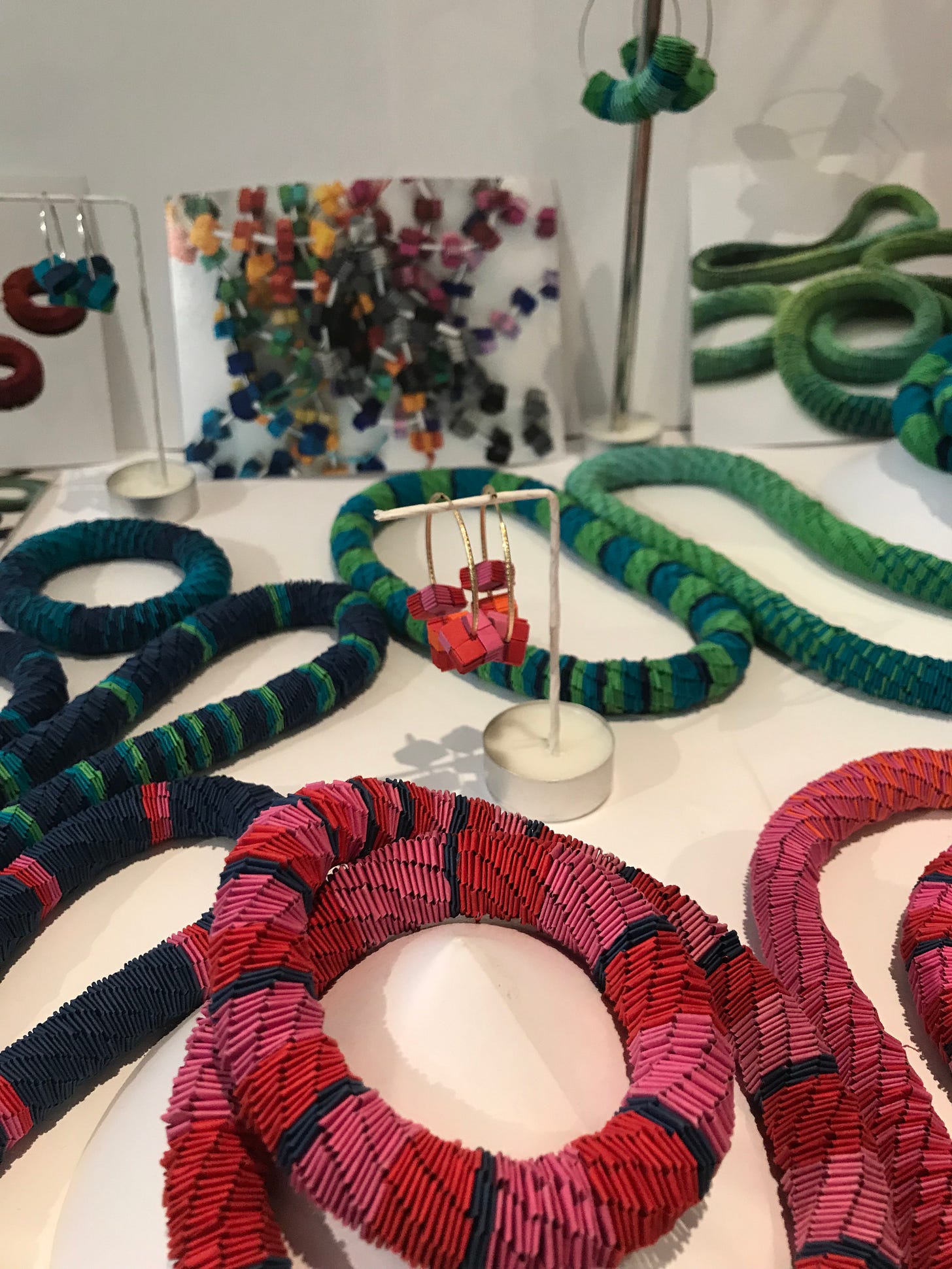
This is a wonderful article
I raced over to Douglas to look at her work and it is so lovely and interesting
Thanks JJ
sehr,sehr schön Rike !!! Viel Erfolg und alles Gute,Glöcky